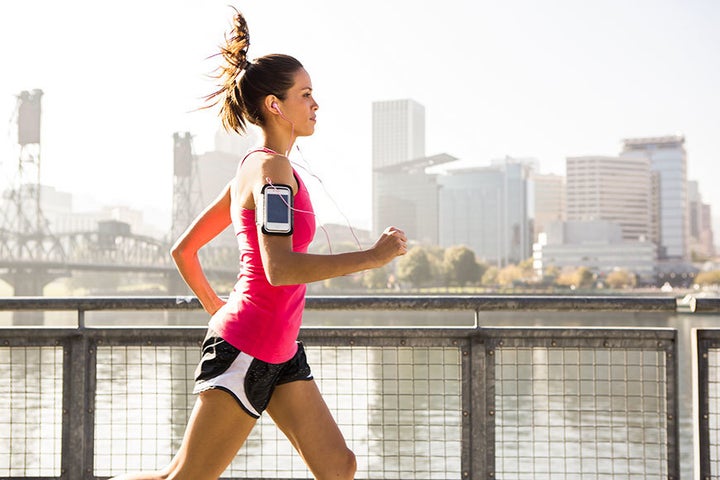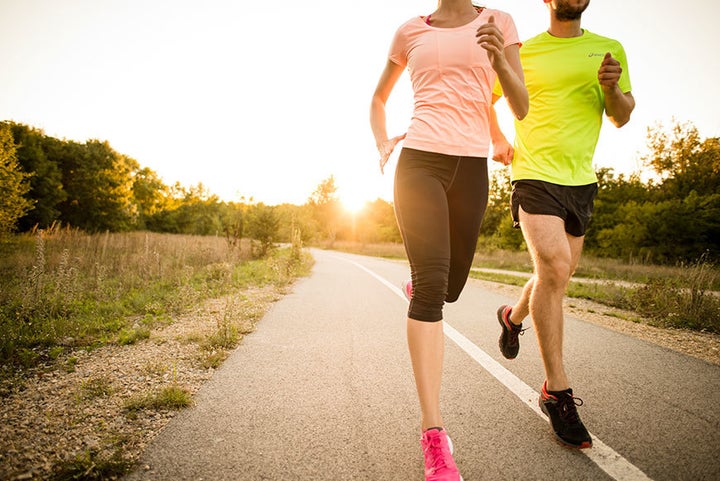For SELF, by Alexa Tucker.

Heading out for a run always sounds like a great idea in theory. Your shoes are all laced up, you’ve got your playlist going, and you feel like a badass marathoner for, like, half a mile. But then it’s hot AF and you’re thirsty and your feet hurt and you can’t breathe and your thighs are chafing and someone is stabbing you in the side and oh my God, make it stop.
Even though running sometimes feels like literal hell, there’s hope for those of us who really, really want to enjoy running. And SELF.com’s lifestyle editor Zahra Barnes, 26, is living, breathing, jogging proof that it can happen—signing up for a 10K forced her to have a change of heart. “Even though running definitely straight up sucks sometimes, there is absolutely nothing like the runner’s high you get mid-run, and the even better one you get when you run your longest distance yet,” she shares. Read her entire bed-to-10K journey here.
Going for a run may not always be mind-blowingly amazing, but it doesn’t have to suck. Here are eight things you can do to help make those tough runs feel way better.
1. Thigh chafing doesn’t have to be a thing.

Chafing thighs just might be the worst thing about running, but thankfully, there are some easy ways to prevent it. Barnes’ surefire method is simple: she runs in leggings. No contact, no problem. But if you don’t want to part ways with your running shorts, products like Body Glide (a favorite among runners) creates a protective barrier along your skin to reduce the friction that causes chafing. In a pinch, you can also go for the good old deodorant trick by rubbing the stuff on your inner thighs, à la Amy Schumer at the Met Gala. (Psst—these fixes are great for hot, humid days when you’re not actually running, too.)
2. Wearing the right socks can help prevent blisters.
You can just feel a painful blister forming. And once it starts, it seems like there’s no stopping a blister in its tracks. “Blisters are caused by friction between your shoes or socks rubbing against your toes and feet,” says Gary Berard, an NYC-based running coach and the founder of GB Running. “Foot abnormalities, ill-fitting shoes, running at a faster pace, or changing running form can all contribute to blisters. Heat and moisture also up the chance for blisters.”
To prevent painful blisters, choose synthetic, non-cotton socks, like a wicking poly-blend sock, suggests Berard. You can also use Body Glide between your toes to prevent blister-causing friction there, he adds. And, of course, make sure your shoes fit correctly.
If you do end up with a gnarly blister, you can lance it with something sharp and sterile to drain the fluid (lovely)—here’s exactly how to deal with them and other all-too-real foot problems runners deal with.
3. Take control of your breath.
If you find yourself huffing and puffing just a few minutes into a run, the answer could be as simple as running more, says Debora Warner, the president and CEO of Mile High Run Club (and a running coach herself). That lungs-are-burning feeling might be a sign that you’re pushing too hard. Ideally, your breath should be under control unless you’re doing speed work or you’re heading up a hill, she adds.
If you find yourself struggling to catch your breath during a steady run, “slow down or take a walking break,” she says. Here’s more on exactly how you should breathe during a run. Breathing properly is also important if you get an annoying side stitch out of nowhere. While the jury’s out on exactly what causes them, Warner says that slow, deep exhales from the diaphragm can help ease the pain.
4. Cut back on long, slow miles and focus on speedy intervals.
If you’ve been running for a while and find that you’re not really getting any faster, either in the time in your minute per mile pace or your overall 5K time, try incorporating some short speed intervals into your routine, says Warner. Even though you’re running fewer miles in these types of training sessions, you can actually see a speed payoff during your usual, longer runs.
“Speed training helps push the lactate threshold back, which means the runner can go further and faster without accumulating as much lactate in the blood,” explains Warner. “Oxygen utilization becomes more efficient with an improved VO2 max as a result of this type of training stimulus.”
Warner suggests that speed work and intervals make up one-third of your overall running program. So, if you run three days a week, one of those days should incorporate some fast runs if you want to keep improving. Interval training is also one of the best ways to utilize a treadmill if the weather gets in the way of your run. (Plus, it’s amazing for burning fat, if that’s one of your goals.)
5. Feel motivated AF with a killer playlist.

Sometimes running can be really boring. Especially those long, slow, endurance training runs. The easy fix? Mixing up your route so that you’re not trudging along the same miles every single time. Having some solid music to jam to is also a must. “Some days the only thing that gets me out of the house is adding an exciting new song to my playlist,” says Barnes. Podcasts work too, if that’s your thing.
Another option? Turn running into a community activity. “I started running with Nike Run Club, which was a fun way to meet people, change up my running routine, and add some great agility and interval work to my runs,” says Barnes. No club nearby? Grab a buddy to run with it that’s what gets you motivated.
6. Be flexible with your running plan depending on how damn hot it is outside.
Chafing is just the beginning of #runnerprobz when it comes to extra-toasty days. It’s important to adjust your expectations for running in the heat, because the hotter you get, the more energy your body uses to cool you down (rather than powering your run), explains Berard. “In most cases, runners will tire more quickly in the heat than they would in cooler temperatures. This doesn’t mean runners must immediately abandon the run altogether, but it does mean that an adjustment of mental expectations and target pacing (AKA, how fast you run) is necessary.”
Try slowing down your pace by 30 seconds for every five degrees above 55 degrees, explains Warner. So, if you run a nine-minute mile in 55-degree weather, you should aim 10-minute mile in 65-degree weather to help make sure that you’re not pushing yourself too hard (and you don’t risk overheating).
Dress smartly, too. “No cotton anything,” says Berard. “Select light clothes made from synthetic materials designed to wick sweat away from the body.” This will help prevent you from overheating. Also, make sure you’re staying hydrated and try to plan your run around the coolest parts of the day, like early in the morning or later at night, Berard adds.
7. Shin splints are common, but here’s how to deal with them.
Shin pain can really get in the way of that runner’s high you’re after. “My runs have been plagued by pretty debilitating lower-leg pain,” says Barnes, so she turned to the experts for advice. If you’re experiencing pain, check in with your doctor for a personalized care routine, but here is what the experts told Barnes:
- Shorten your stride. Barnes received this advice from sports medicine doctor Jordan Metzl, M.D., a dedicated marathon runner and author of Jordan Metzl’s Running Strong. “This is one major thing that has helped with the pain.”
- Pay attention to your cadence, said Rachel Hill, physical therapist, orthopedic clinical specialist, certified running coach, and owner of the Washington, D.C. area-based PROAction Physical Therapy. “I wasn’t moving my feet quickly enough, so I spent too much time on the ground, which put too much pressure on my lower legs,” Barnes explains.
While these things have made a big difference in Barnes’ shin pain, Berard says he finds that the best option is prevention. “Increase your mileage safely and ensure that you’re wearing the proper running shoes,” says Berard. Also, try incorporating gentle calf stretches, like these, before and after your runs. If your shin pain is really bugging you, though, Berard suggests seeing a doctor to make sure it’s not more serious than shin splints (like a stress fracture).
8. And finally, don’t hold a water bottle (or phone), in your hands.

OK, so you’re supposed to stay hydrated during a run, but heading out with a water bottle in your hand is a running no-no. “Too often I see runners holding water bottles or smart phones, which throws off the gait and arm swing and can lead to asymmetrical movement patterns,” says Warner.
Skipping water entirely isn’t a great option either, though. Download an app like OasisPlaces to help keep track of where water fountains around your run path are. “On really hot days, I wear a Camelback so I can make sure to stay hydrated,” says Barnes. You can also buy running belts that hold mini water bottles and typically have a pocket for you to stash your phone, too.
At the end of the day, there are a lot of less-than-amazing things about running, but there are a lot of amazing things that happen when you log a few miles, too!
“It’s definitely worth troubleshooting whatever’s going on, because running can be an incredible. I’m a total convert,” says Barnes. And you can be, too—or not, and that’s OK, too. It’s all about finding the workout works best for you.
More From SELF: